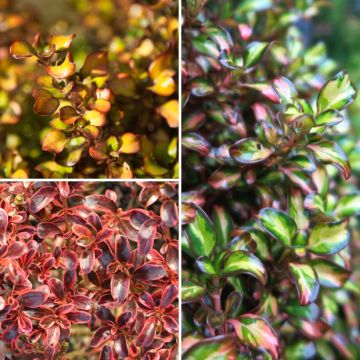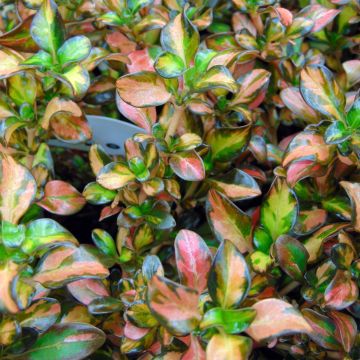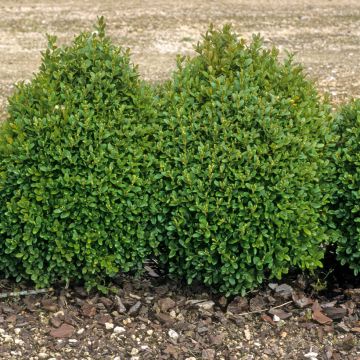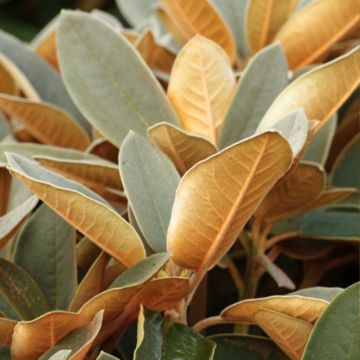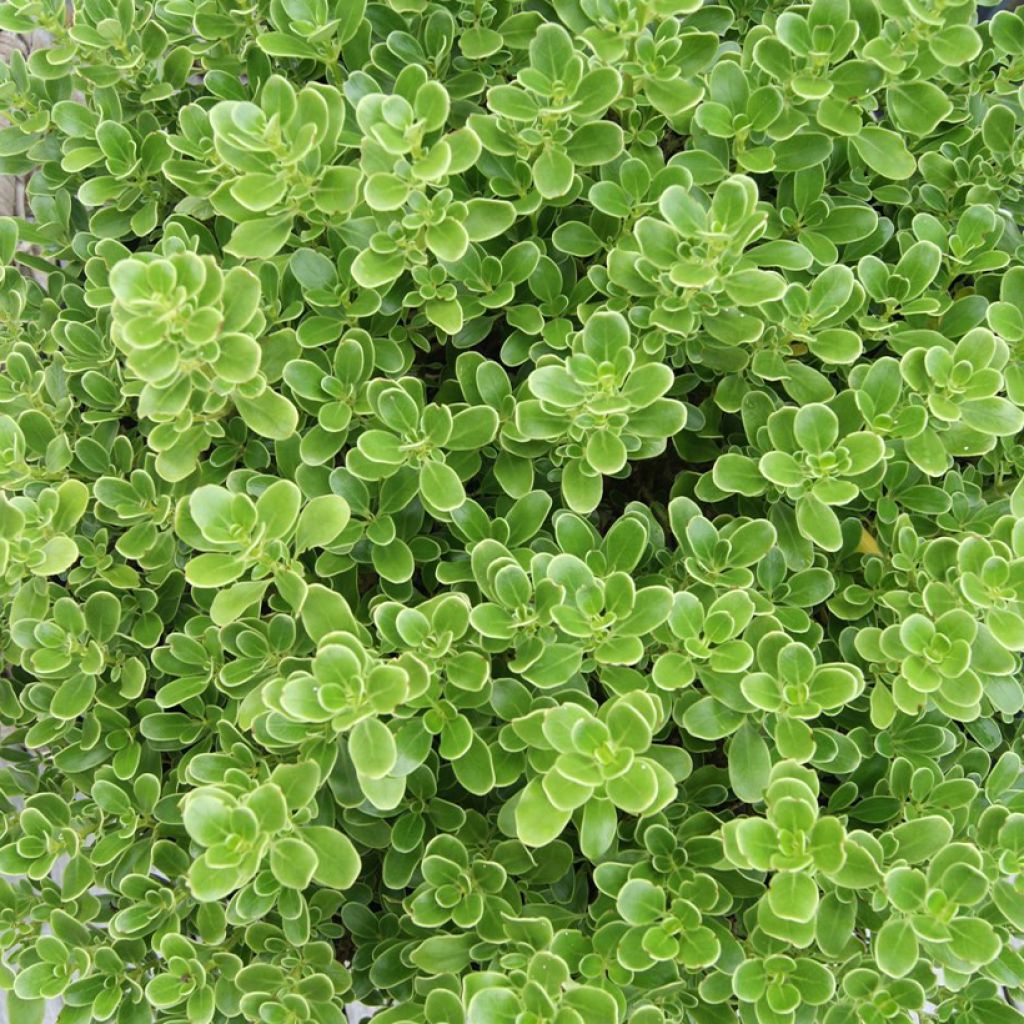

Coprosma Mini Mac - Plante miroir
Coprosma Mini Mac
Coprosma Mini Mac
Mirror Plant, Looking-glass plant
Why not try an alternative variety in stock?
View all →This plant carries a 24 months recovery warranty
More information
We guarantee the quality of our plants for a full growing cycle, and will replace at our expense any plant that fails to recover under normal climatic and planting conditions.
From €5.90 for pickup delivery and €6.90 for home delivery
Express home delivery from €8.90.
Delivery to Corse prohibited: UE law prohibits the import of this plant from mainland France to Corse as part of the fight against Xylella fastidiosa. Please accept our sincere apologies.
More information
Does this plant fit my garden?
Set up your Plantfit profile →
Description
Coprosma 'Mini Mac' is a green ball of light for the garden or terrace. This small evergreen bush has a rather exceptional density of vegetation, and it is easy to maintain a nice shape through light annual pruning. Originally from New Zealand, it is not very hardy, but it is drought-resistant and very tolerant of sea spray. In the ground, it is an ideal plant for coastal gardens. Elsewhere, it will adorn the terrace or balcony throughout the summer and spend the winter protected from frost.
The 'Mini Mac' coprosma is a small variety. The Coprosma genus consists of 90 species of evergreen bushes and small trees, most of which are native to New Zealand. These plants belong to the Rubiaceae family, which includes, for example, Sweet Woodruff, Coffee, and Gardenia. Recently introduced to the European horticultural market, these bushes, nicknamed mirror plants, develop extremely shiny foliage where light and colours play wonderfully. From their origins, these tender bushes have retained a preference for dry and warm climates and poor, well-drained soils. Hybrids and cultivars are not very hardy, and the plants begin to suffer from temperatures below -5°C (23 °F). Therefore, their cultivation in the ground will be reserved for coastal areas spared from heavy frosts.
The 'Mini Mac' Coprosma has a naturally rounded and compact habit, reaching about 50 cm (19.7 in) in all directions within 4 or 5 years. It develops foliage composed of small, lanceolate, leathery, and shiny leaves. Their colour is initially tender green and becomes darker as the season progresses. The discreet flowering occurs at the end of summer in tufts of greenish stamens or stigmas, carried by male or female flowers on separate plants. The frost resistance of this variety is estimated at around -8°C (17.6 °F) at its lowest, in very well-drained soil.
Coprosma 'Mini Mac' is a bush with a modern and precious appearance, very ornamental when it lives in a pot on the terrace or balcony. It can be associated, in a border, with other green foliage plants (Lonicera nitida, Lonicera pileata), variegated (Emerald Gaiety Euonymus), purple, like dwarf Berberis, or grey, like small Artemisia. The small blue flowers of some shrubby salvias or Felicia will pose blue flashes on the ice of its foliage. Pot cultivation is essential in regions where frost is significant in winter, but the coprosma tolerates it very well. This bush requires some precautions to acclimatize to the ground in gardens: it prefers light, poor, and non-chalky soils.
Report an error about the product description
Coprosma Mini Mac in pictures


Plant habit
Flowering
Foliage
Botanical data
Coprosma
Mini Mac
Rubiaceae
Mirror Plant, Looking-glass plant
Oceania
Other Coprosma
Planting and care
Coprosma 'Mini Mac' thrives in open ground in coastal regions spared from severe frost. It is best planted in spring, in full sun or partial shade. It is a plant that tolerates drought and adapts to poor soils but dislikes the presence of limestone. Plant it in light and well-drained soil, for example, a mix of leaf compost, ericaceous soil, and river sand. Avoid repeated watering with hard water. The planting hole should be twice the size of the root ball. Water regularly to aid establishment. Once well established, the Coprosma can do without watering in summer in most regions.
Pruning is not essential, if necessary prune sparingly between April and August. Water plants grown in containers regularly. In cold regions, bring them indoors to a cool, bright room with little or no heating, before the arrival of severe frost.
Modern hybrids seem to be less prone to attacks from scale insects and sooty mould. However, plants grown in greenhouses will be more exposed to these pests and diseases.
Planting period
Intended location
Care
This item has not been reviewed yet - be the first to leave a review about it.
Evergreen shrubs
Haven't found what you were looking for?
Hardiness is the lowest winter temperature a plant can endure without suffering serious damage or even dying. However, hardiness is affected by location (a sheltered area, such as a patio), protection (winter cover) and soil type (hardiness is improved by well-drained soil).

Photo Sharing Terms & Conditions
In order to encourage gardeners to interact and share their experiences, Promesse de fleurs offers various media enabling content to be uploaded onto its Site - in particular via the ‘Photo sharing’ module.
The User agrees to refrain from:
- Posting any content that is illegal, prejudicial, insulting, racist, inciteful to hatred, revisionist, contrary to public decency, that infringes on privacy or on the privacy rights of third parties, in particular the publicity rights of persons and goods, intellectual property rights, or the right to privacy.
- Submitting content on behalf of a third party;
- Impersonate the identity of a third party and/or publish any personal information about a third party;
In general, the User undertakes to refrain from any unethical behaviour.
All Content (in particular text, comments, files, images, photos, videos, creative works, etc.), which may be subject to property or intellectual property rights, image or other private rights, shall remain the property of the User, subject to the limited rights granted by the terms of the licence granted by Promesse de fleurs as stated below. Users are at liberty to publish or not to publish such Content on the Site, notably via the ‘Photo Sharing’ facility, and accept that this Content shall be made public and freely accessible, notably on the Internet.
Users further acknowledge, undertake to have ,and guarantee that they hold all necessary rights and permissions to publish such material on the Site, in particular with regard to the legislation in force pertaining to any privacy, property, intellectual property, image, or contractual rights, or rights of any other nature. By publishing such Content on the Site, Users acknowledge accepting full liability as publishers of the Content within the meaning of the law, and grant Promesse de fleurs, free of charge, an inclusive, worldwide licence for the said Content for the entire duration of its publication, including all reproduction, representation, up/downloading, displaying, performing, transmission, and storage rights.
Users also grant permission for their name to be linked to the Content and accept that this link may not always be made available.
By engaging in posting material, Users consent to their Content becoming automatically accessible on the Internet, in particular on other sites and/or blogs and/or web pages of the Promesse de fleurs site, including in particular social pages and the Promesse de fleurs catalogue.
Users may secure the removal of entrusted content free of charge by issuing a simple request via our contact form.
The flowering period indicated on our website applies to countries and regions located in USDA zone 8 (France, the United Kingdom, Ireland, the Netherlands, etc.)
It will vary according to where you live:
- In zones 9 to 10 (Italy, Spain, Greece, etc.), flowering will occur about 2 to 4 weeks earlier.
- In zones 6 to 7 (Germany, Poland, Slovenia, and lower mountainous regions), flowering will be delayed by 2 to 3 weeks.
- In zone 5 (Central Europe, Scandinavia), blooming will be delayed by 3 to 5 weeks.
In temperate climates, pruning of spring-flowering shrubs (forsythia, spireas, etc.) should be done just after flowering.
Pruning of summer-flowering shrubs (Indian Lilac, Perovskia, etc.) can be done in winter or spring.
In cold regions as well as with frost-sensitive plants, avoid pruning too early when severe frosts may still occur.
The planting period indicated on our website applies to countries and regions located in USDA zone 8 (France, United Kingdom, Ireland, Netherlands).
It will vary according to where you live:
- In Mediterranean zones (Marseille, Madrid, Milan, etc.), autumn and winter are the best planting periods.
- In continental zones (Strasbourg, Munich, Vienna, etc.), delay planting by 2 to 3 weeks in spring and bring it forward by 2 to 4 weeks in autumn.
- In mountainous regions (the Alps, Pyrenees, Carpathians, etc.), it is best to plant in late spring (May-June) or late summer (August-September).
The harvesting period indicated on our website applies to countries and regions in USDA zone 8 (France, England, Ireland, the Netherlands).
In colder areas (Scandinavia, Poland, Austria...) fruit and vegetable harvests are likely to be delayed by 3-4 weeks.
In warmer areas (Italy, Spain, Greece, etc.), harvesting will probably take place earlier, depending on weather conditions.
The sowing periods indicated on our website apply to countries and regions within USDA Zone 8 (France, UK, Ireland, Netherlands).
In colder areas (Scandinavia, Poland, Austria...), delay any outdoor sowing by 3-4 weeks, or sow under glass.
In warmer climes (Italy, Spain, Greece, etc.), bring outdoor sowing forward by a few weeks.


































